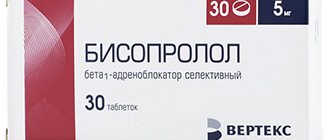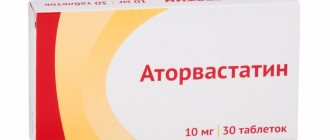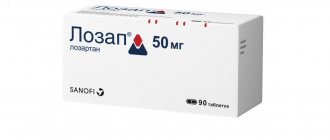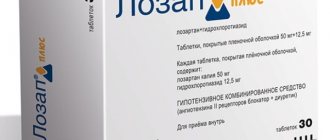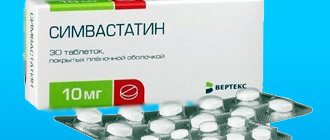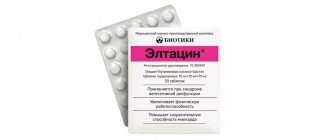Products
Composition: 1 tablet (5 mg) contains: active substance: amlodipine besylate - 5 mg, excipients: corn (potato) starch - 4.57 mg, lactose - 156 mg, microcrystalline cellulose - 9 mg, magnesium stearate - 3.5 mg
DESCRIPTION
Flat-cylindrical tablets from white to white with a creamy tint. Light marbling is allowed.
PHARMACOTHERAPEUTIC GROUP
Calcium channel blocker. ATX CODE C08CA01.
PHARMACHOLOGIC EFFECT
Antianginal, hypotensive. By binding to dihydropyridine receptors, it blocks calcium channels, reduces the transmembrane transition of calcium ions into the cell (more into vascular smooth muscle cells than cardiomyocytes).
PHARMACOKINETICS
After oral administration, it is slowly absorbed from the gastrointestinal tract. The average absolute bioavailability is 64%, Tmax is 6-9 hours. Equilibrium concentration is achieved after 7 days of therapy. Food does not affect the absorption of amlodipine. The mean volume of distribution is 21 L/kg body weight, indicating that most of the drug is in the tissues and a relatively smaller portion is in the blood. Communication with blood plasma proteins – 95%. Subject to slow but extensive metabolism (90%) in the liver, it has a “first pass” effect through the liver. Metabolites do not have significant pharmacological activity. After a single oral dose, T1/2 varies from 31 to 48 hours, and with repeated administration it is approximately 45 hours. About 60% of the dose taken orally is excreted in the urine mainly in the form of metabolites and 10% unchanged, 20 - 25% is excreted in feces , as well as with breast milk. The total Cl of amlodipine is 0.116 ml/s/kg (7 ml/min/kg, 0.42 l/h/kg). In elderly patients (over 65 years of age), the elimination of amlodipine is slower (T1/2 - 65 hours) compared to young patients, but the difference is not clinically significant. Prolongation of T1/2 in patients with liver failure up to 60 hours suggests that with long-term administration the accumulation of the drug in the body will be higher. Renal failure does not significantly affect the kinetics of amlodipine. The drug penetrates the BBB. It is not removed by hemodialysis.
INDICATIONS FOR USE
Arterial hypertension (monotherapy or in combination with other antihypertensive drugs); angina pectoris (including exertional angina), vasospastic angina (Prinzmetal's angina); silent myocardial ischemia; decompensated chronic heart failure (auxiliary therapy).
CONTRAINDICATIONS
Hypersensitivity, including to other dihydropyridine derivatives, severe arterial hypotension, collapse, cardiogenic shock, acute myocardial infarction (including 1 month after it), pregnancy and lactation, age under 18 years (efficacy and safety not installed). With caution: impaired liver function, sick sinus syndrome (severe bradycardia, tachycardia), decompensated chronic heart failure, mild or moderate arterial hypotension, aortic stenosis, mitral stenosis, hypertrophic obstructive cardiomyopathy, diabetes mellitus, lipid profile disorders, old age.
METHOD OF APPLICATION AND DOSES
Inside. For arterial hypertension and angina pectoris: initial dose - 5 mg 1 time per day; maximum dose – 10 mg 1 time per day; for arterial hypertension, the maintenance dose is 2.5 ÷ 5 mg/day. For angina pectoris and vasospastic angina - 5÷10 mg/day, once; for the prevention of angina attacks – 10 mg/day. For chronic heart failure – 2.5 mg/day. Once, if well tolerated, the dose is gradually increased to 10 mg/day. For thin patients, short patients, elderly patients, with impaired liver function, amlodipine is prescribed as an antihypertensive agent at an initial dose of 2.5 mg, and as an antianginal agent - 5 mg. Does not require dose changes when administered concomitantly with thiazide diuretics and ACE inhibitors. Does not require dose changes in patients with renal failure.
SIDE EFFECT
From the cardiovascular system: palpitations, shortness of breath, marked decrease in blood pressure, fainting, vasculitis, edema (ankles and feet), flushing of the face, rarely - rhythm disturbances (bradycardia, ventricular tachycardia, atrial flutter), pain in chest, orthostatic hypotension, very rarely - development or worsening of heart failure, extrasystole, migraine; From the nervous system: dizziness, headache, fatigue, drowsiness, mood changes, convulsions, rarely - loss of consciousness, hypoesthesia, nervousness, paresthesia, tremor, vertigo, asthenia, malaise, insomnia, depression, unusual dreams, very rarely - ataxia, apathy, agitation, amnesia; From the urinary system: rarely - pollakiuria, painful urge to urinate, nocturia, sexual dysfunction (including decreased potency), very rarely - dysuria, polyuria; From the skin: very rarely - xeroderma, alopecia, dermatitis, purpura, skin discoloration; From the gastrointestinal tract: nausea, vomiting, epigastric pain, rarely - pancreatitis, dry mouth, flatulence, gingival hyperplasia, constipation or diarrhea, jaundice, very rarely - gastritis, increased appetite. Allergic reactions: skin itching, rash (including erythematous, maculopapular urticaria), angioedema. Other: gynecomastia, hyperuricemia, weight gain/loss, thrombocytopenia, leukopenia, hyperglycemia, blurred vision, diplopia, conjunctivitis, eye pain, back pain, dyspnea, nosebleeds, increased sweating, thirst, very rarely - cold sticky sweat, cough, rhinitis, parosmia, disturbance of taste, disturbance of accommodation, xerophthalmia.
OVERDOSE
Symptoms: marked decrease in blood pressure, tachycardia, excessive peripheral vasodilation. Treatment: gastric lavage, administration of activated charcoal, maintaining the function of the cardiovascular system, monitoring indicators of heart and lung function, elevated position of the extremities, monitoring circulating blood volume and diuresis. To restore vascular tone - use vasoconstrictor drugs (in the absence of contraindications to their use), to eliminate the consequences of blockade of calcium channels - intravenous administration of calcium gluconate. Hemodialysis is not effective.
INTERACTION with other drugs
Compatible with the main groups of antihypertensive drugs (diuretics, ACE inhibitors, beta-blockers), nitrates and hypoglycemic drugs. Inhalation anesthetics (hydrocarbon derivatives), amiodarone, quinidine and other calcium antagonists can enhance the effect. NSAIDs (especially indomethacin) reduce the hypotensive effect, inhibit the synthesis of prostaglandins in the kidneys and natriuresis.
special instructions
During treatment, monitoring of body weight and sodium intake is necessary. You should maintain dental hygiene and visit the dentist frequently. When increasing the dose, careful monitoring of elderly patients is necessary. The drug does not affect plasma concentrations of K+, glucose, triglycerides, total cholesterol, LDL, uric acid, creatinine and urea nitrogen.
Precautionary measures
Caution must be exercised when prescribing to patients with hepatic and/or renal failure or chronic heart failure. At the beginning of treatment, dizziness and drowsiness are possible; in this case, special precautions must be taken when driving a car and when working with machinery.
Release form
Tablets of 5 and 10 mg. 10 tablets per blister pack. 40, 50, etc. up to 100 tablets per polymer jar. Each jar, or 1, 2 or 3 blisters, along with instructions for use, is placed in a cardboard pack.
Storage conditions
Store in a dry place, protected from light, at a temperature not exceeding 250C. Keep out of the reach of children.
Best before date
2 years. Do not use after the expiration date stated on the package.
Amlodipine - Prana tablet 10 mg x40
Amlodipine-Prana tablet 10 mg x40 ATX code: C08CA01 (Amlodipine) Active substance: amlodipine (amlodipine) Rec.INN registered by WHO
Dosage form
AMLODIPINE-PRANA
tab. 10 mg: 10, 20, 30, 40, 50, 60, 70, 80, 90 or 100 pcs.reg. No.: LSR-000849/10 from 02.10.10 - Indefinitely
Release form, composition and packaging
Tablets 1 tab.
amlodipine (in the form of besilate) 10 mg Clinical and pharmacological group: Calcium channel blocker Pharmaco-therapeutic group: BMCC Open the description of the active components of the drug AMLODIPINE-PRANA
Pharmacological action: Selective class II calcium channel blocker. The antihypertensive effect is due to a direct relaxing effect on vascular smooth muscle. It is assumed that the antianginal effect of amlodipine is associated with its ability to dilate peripheral arterioles, this leads to a decrease in peripheral vascular resistance, and reflex tachycardia does not occur. As a result, there is a decrease in myocardial oxygen demand and energy consumption by the heart muscle. On the other hand, amlodipine appears to cause dilation of large-caliber coronary arteries and coronary arterioles in both intact and ischemic areas of the myocardium. This ensures the supply of oxygen to the myocardium during spasms of the coronary arteries.
Pharmacokinetics
When taken orally, it is absorbed from the gastrointestinal tract slowly and almost completely, Cmax in blood plasma is achieved within 6-9 hours. Protein binding is 95-98%. Subjects to minimal first-pass metabolism and slow but significant hepatic metabolism to metabolites with little pharmacological activity.
T1/2 averages 35 hours and with arterial hypertension can increase to an average of 48 hours, in elderly patients - up to 65 hours and in case of liver dysfunction - up to 60 hours. Excreted mainly in the form of metabolites: 59-62% - by the kidneys , 20-25% - through the intestines.
Indications
Arterial hypertension (as monotherapy or as part of combination therapy).
Stable angina, unstable angina, Prinzmetal's angina (as monotherapy or as part of combination therapy).
ICD-10 codes
ICD-10 code Indication
I10 Essential [primary] hypertension
I20 Angina pectoris
I20.0 Unstable angina
I20.1 Angina with documented spasm (Prinzmetal's angina, variant angina)
Dosage regimen
For adults, when taken orally, the initial dose is 5 mg 1 time / day. If necessary, the dose can be increased.
Maximum dose: when taken orally - 10 mg/day.
Side effect
From the cardiovascular system: peripheral edema, tachycardia, hyperemia of the skin, when used in high doses - arterial hypotension, arrhythmias, shortness of breath.
From the digestive system: nausea, abdominal pain, rarely - gum hyperplasia.
From the central nervous system and peripheral nervous system: headache, fatigue, drowsiness, dizziness, with prolonged use - paresthesia.
Allergic reactions: skin rash, itching.
Other: with long-term use - pain in the limbs.
Contraindications for use
Severe arterial hypotension (systolic blood pressure less than 90 mm Hg), left ventricular outflow tract obstruction (including severe aortic stenosis), hemodynamically unstable heart failure after myocardial infarction, children and adolescents under 18 years of age (efficacy and safety have not been established), hypersensitivity to amlodipine and other dihydropyridine derivatives.
Use during pregnancy and breastfeeding
The safety of amlodipine during pregnancy has not been established, so use is only possible if the expected benefit to the mother outweighs the potential risk to the fetus.
There are no data indicating the excretion of amlodipine in breast milk. However, other calcium channel blockers (dihydropyridine derivatives) are known to be excreted in breast milk. In this regard, if it is necessary to use amlodipine during lactation, the issue of stopping breastfeeding should be decided.
Use for liver dysfunction Use with caution in liver dysfunction.
Use for impaired renal function Use with caution in impaired renal function.
Use in children There are no clinical data on the use of amlodipine in pediatrics.
Use in elderly patients Elderly patients do not require dose reduction.
special instructions
Use with caution in patients with liver failure, chronic heart failure of non-ischemic etiology of functional class III-IV according to the NYHA classification, unstable angina, aortic stenosis, mitral stenosis, hypertrophic obstructive cardiomyopathy, acute myocardial infarction (and within 1 month after it), SSS (severe tachycardia, bradycardia), arterial hypotension, when used simultaneously with inhibitors or inducers of the CYP3A4 isoenzyme.
During the use of amlodipine in patients with chronic heart failure (class III and IV according to the NYHA classification) of non-ischemic origin, an increase in the incidence of pulmonary edema was observed, despite the absence of signs of worsening heart failure.
In elderly patients, T1/2 may increase and amlodipine clearance may decrease. No dose changes are required, but more careful monitoring of patients in this category is necessary.
The effectiveness and safety of amlodipine in hypertensive crisis has not been established.
Despite the absence of withdrawal syndrome with slow calcium channel blockers, it is advisable to discontinue treatment with amlodipine gradually.
There are no clinical data on the use of amlodipine in pediatrics.
Drug interactions
It is possible to enhance the antianginal and antihypertensive effect of slow calcium channel blockers when used together with thiazide and loop diuretics, ACE inhibitors, beta-blockers and nitrates, as well as enhance their antihypertensive effect when used together with alpha1-blockers, antipsychotics.
Although negative inotropic effects have not generally been observed in amlodipine studies, some calcium channel blockers may enhance the negative inotropic effects of antiarrhythmic drugs that cause QT prolongation (eg, amiodarone and quinidine).
Simultaneous repeated use of amlodipine at a dose of 10 mg and simvastatin at a dose of 80 mg leads to an increase in the bioavailability of simvastatin by 77%. In such cases, the dose of simvastatin should be limited to 20 mg.
Antiviral drugs (for example, ritonavir) increase plasma concentrations of slow calcium channel blockers, incl. amlodipine.
With the simultaneous use of sympathomimetics and estrogens, the antihypertensive effect may be reduced due to sodium retention in the body.
Neuroleptics and isoflurane enhance the antihypertensive effect of dihydropyridine derivatives. With the simultaneous use of inhalation anesthesia, the hypotensive effect may be enhanced.
With simultaneous use of amiodarone, the antihypertensive effect may be enhanced.
With simultaneous use of lithium carbonate, manifestations of neurotoxicity (including nausea, vomiting, diarrhea, ataxia, tremors and/or tinnitus) are possible.
With simultaneous use, orlistat reduces the antihypertensive effect of amlodipine, which can lead to a significant increase in blood pressure and the development of a hypertensive crisis.
With the simultaneous use of indomethacin and other NSAIDs, the antihypertensive effect of amlodipine may be reduced due to inhibition of prostaglandin synthesis in the kidneys and fluid retention under the influence of NSAIDs.
With simultaneous use of quinidine, the antihypertensive effect may be enhanced.
Calcium supplements may reduce the effect of slow calcium channel blockers.
With simultaneous use of diltiazem (CYP3A4 isoenzyme inhibitor) at a dose of 180 mg and amlodipine at a dose of 5 mg in elderly patients (69 to 87 years) with arterial hypertension, an increase in the bioavailability of amlodipine by 57% was observed. Concomitant use of amlodipine and erythromycin in healthy volunteers (18 to 43 years of age) does not lead to significant changes in amlodipine exposure (22% increase in AUC). Although the clinical significance of these effects is unclear, they may be more pronounced in older patients. Potent inhibitors of the CYP3A4 isoenzyme (for example, ketoconazole, itraconazole) may increase the plasma concentration of amlodipine to a greater extent than diltiazem. Amlodipine and inhibitors of the CYP3A4 isoenzyme should be used with caution.
There are no data on the effect of inducers of the CYP3A4 isoenzyme on the pharmacokinetics of amlodipine. Blood pressure should be carefully monitored while using amlodipine and inducers of the CYP3A4 isoenzyme.
Amlodipine analogues: what to replace the drug with?
The manufacturer of the original drug called “Norvasc” (pharmaceutical company Pfizer, USA) produces the drug in dosages of 5 and 10 mg.
Generics are medicines with identical amounts of active ingredients, but at a lower cost. The high price of the original drug, high demand due to the frequent prescription of medications of this group are the main reasons for the appearance of domestic and imported analogues on the Russian market:
- "Amlodipine" Russia;
- "Agen", "Tengisal" Czech Republic;
- “Azomex”, “Amlovas”, “Amlogen”, “Vazodipine” India;
- Amlo-Sandoz Poland/Slovenia;
- Amlodipine-Pfizer Germany;
- "Amlocard-Sanovel", "Norvadin" Türkiye;
- "Amlocor" Bulgaria;
- "Amlodipine-Zentiva" Israel;
- "Normodipin", "Emlodin" Hungary;
- "Tenox" Slovenia.
Drug substitutes are drugs with a similar pharmacodynamic effect and a list of indications due to the influence of another active ingredient. The main substitutes for Amlodipine are representatives of other classes of calcium channel blockers:
- "Nifedipine" ("Corinfar", "Kordipin", "Osmo-Adalat");
- "Lecardipine" ("Lerkamen");
- "Felogexal" Germany;
- "Nitresal" Czech Republic;
- "Nimodipine."
The pharmaceutical market offers combination drugs of Amlodipine with other antihypertensive drugs. Taking a substitute without consulting a doctor is strictly prohibited. Different active ingredients differ in the spectrum and severity of their effects, and their compatibility with medications taken.
Instructions for use of "Amlodipine"
In the membranes of smooth muscle cells of arteries, cardiomyocytes, sinus and atrioventricular nodes, there are voltage-dependent slow Ca2+ channels of L- and T-type. Amlodipine slows down the transport of calcium ions into the cytoplasm, preventing the interaction of the contractile proteins actin and myosin.
The drug belongs to the subgroup of dihydropyridine antagonists, which have a vasodilator effect without changing myocardial contractility and sinus node automatism. Therefore, Amlodipine is considered a vasoselective representative of the class.
Main effects of the drug:
- Antihypertensive. The drug acts primarily on the smooth muscles of peripheral arterioles of medium and small caliber. Blockade of calcium entry into the cytoplasm causes cell relaxation, the lumen expands, and overall vascular resistance and afterload on the heart muscle decrease.
- Antianginal.
Dilatation of coronary vessels and prevention of repeated spasm ensures adequate blood supply to the working myocardium. Additionally, oxygen consumption is reduced when the afterload on the left side of the heart is corrected, and muscle relaxation in diastole (the phase of blood filling of the coronary vessels) is optimized. Taking Amlodipine by patients with coronary artery disease (CHD) prolongs the period of physical activity until the appearance of chest pain and changes in the ECG. The drug reduces the number of attacks and the need to take Nitroglycerin tablets. - Improvement of microcirculation in the kidneys (regulation of renin production), as a result of which one of the links of arterial hypertension is blocked. Renal vascular resistance decreases, glomerular filtration and plasma flow increase.
- Increases cerebral circulation, prevents ischemic damage (stroke).
- Reducing blood viscosity, inhibiting platelet aggregation, increasing the fibrinolytic ability of plasma. Improving rheological properties has a positive effect on systemic hemodynamics, especially in patients with a long history of coronary heart disease.
- Antiatherogenic effect. Amlodipine prevents the penetration of low-density lipoproteins into endothelial cell membranes, preventing damage to the vascular wall.
- Stimulation of the release of nitric oxide from the vascular endothelium.
For long-acting antihypertensive medications, the main criterion for effectiveness is the ability to “overlap” the 24-hour period, prolonging the effect until the next dose of the drug. The half-life of Amlodipine exceeds 35 hours.
The drug has the most consistently high bioavailability in comparison with other representatives of the class (65-70%). Due to the slow increase in peak concentration in tissues and long-term elimination, a stable blood pressure curve is ensured throughout the day.
Indications: what does it help with and at what pressure is it prescribed?
The drug "Amlodipine" is optimally suited for long-term treatment regimens for chronic conditions. The main groups of indications are presented in the table.
| Disease | Peculiarities |
| Hypertension (HD) |
|
| Coronary heart disease |
|
| Concomitant pathologies associated with ischemic heart disease or hypertension |
|
Amlodipine is suitable for the treatment of hypertension in pregnant women, dark-skinned patients and children over 6 years of age.
Calcium antagonists have a relaxing effect on the muscles of the uterus, which must be taken into account when prescribing the drug in the last weeks of pregnancy.
Directions for use and dosage: how to take?
Taking Amlodipine does not depend on the time of day or diet. The recommended starting dose of saturation is 5 mg 1 time per day. The correction is carried out depending on the patient’s sensitivity to therapy and blood pressure levels. The dosage regimen is assessed and adjusted 14 days from the start of the course.
Con (active metabolic products) in tissues is stabilized after 7 days of systematic use. Due to the smooth increase in the hypotensive effect, there is no risk of reflex acceleration of the pulse or addiction during long-term treatment.
Amlodipine is used for basic monotherapy and in combination with anti-ischemic drugs of other classes for patients suffering from coronary artery disease.
Simultaneous treatment with several antihypertensive drugs does not require revision of the dosage of Amlodipine.
The medicine is used for hypertension in children over 6 years of age. Recommended regimen: starting dose - 2.5 mg/day, if the hypotensive effect is insufficient - correction after 28 days (up to 5 mg/day).
For patients with renal or hepatic insufficiency, elderly people - increasing the dose of the drug is allowed with constant monitoring of hemodynamics.
Sharp restriction or cessation of taking the drug does not cause withdrawal symptoms.
Special instructions and symptoms of overdose
Amlodipine is a widely used drug, so it is necessary to use safe combinations with:
- diuretics ("Hydrochlorothiazide")
- adrenergic receptor blockers (Metoprolol, Bisoprolol and others);
- ACE inhibitors (Ramipril, Lisinopril);
- long-acting nitrates (“Sustak”, “Nitrosorbitol”).
Simultaneous administration of Amlodipine and high doses of Simvastatin contribute to disruption of the metabolism of the latter. The maximum amount of lipid-lowering medication should be limited to 20 mg.
Concomitant use of alcohol with Amlodipine does not affect the rate of ethanol metabolism. International clinical protocols for the treatment of cardiovascular pathologies recommend limiting the amount of alcohol for patients with hypertension or coronary artery disease.
In the first weeks of therapy, the drug affects the ability to drive vehicles and operate complex machinery. A decrease in the severity of the reaction is accompanied by migraines, dizziness and attacks of nausea. At the initial stage of treatment, it is recommended to limit these types of activities.
In case of poisoning with Amlodipine, a drop in tone and dilation of peripheral vessels occurs, which is accompanied by tachycardia, dizziness, collapse (severe arterial hypotension).
Treatment of overdose of Amlodipine:
- gastric lavage;
- administration of drugs that constrict blood vessels;
- infusion of a solution of glucose with calcium;
- constant monitoring of cardiac parameters, central venous pressure, diuresis;
- drug correction of emerging disorders.
"Amlodipine" has strong connections with plasma globulins, so the use of dialysis is ineffective.
Contraindications
The use of Amlodipine is not recommended for the following conditions:
- intolerance to dihydropyridine or other components;
- severe arterial hypotension;
- states of shock;
- obstruction of the left ventricular outflow tract (critical aortic valve stenosis);
- unstable hemodynamic condition for 14 days in patients who have suffered a myocardial infarction;
- progressive angina;
- systolic dysfunction of the left heart (EF less than 40%);
- lines of pregnancy up to 12 weeks.
Side effects
Undesirable effects during treatment with Amlodipine are rare, the main symptoms of which are indicated in the table.
| Frequent reactions |
|
| Rare side effects |
|

